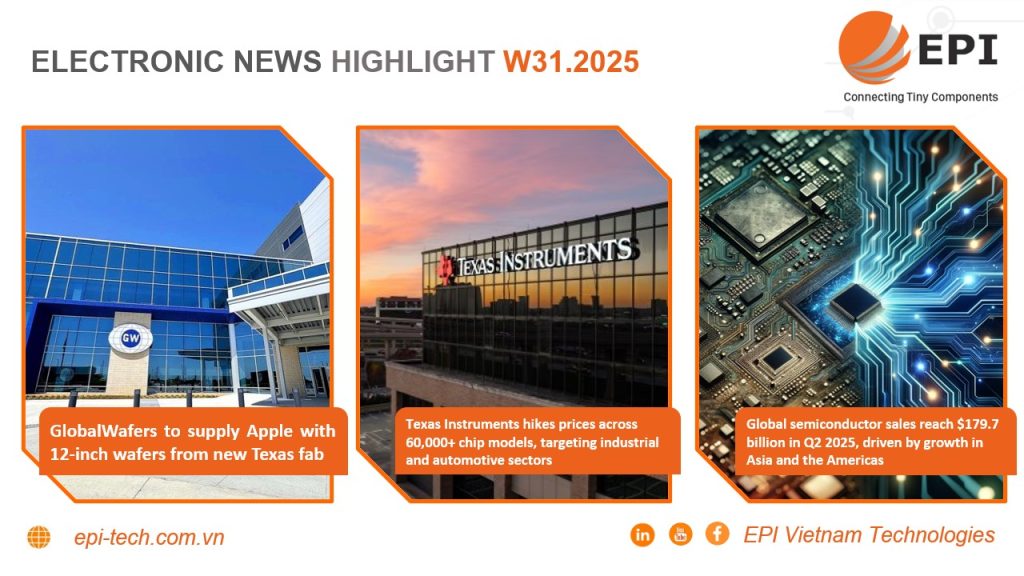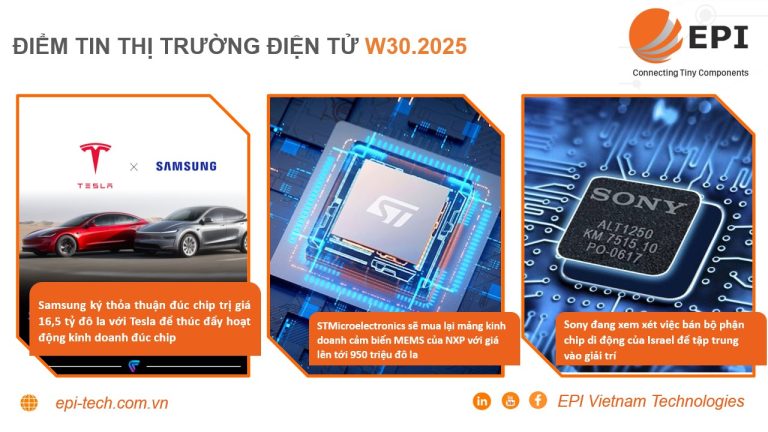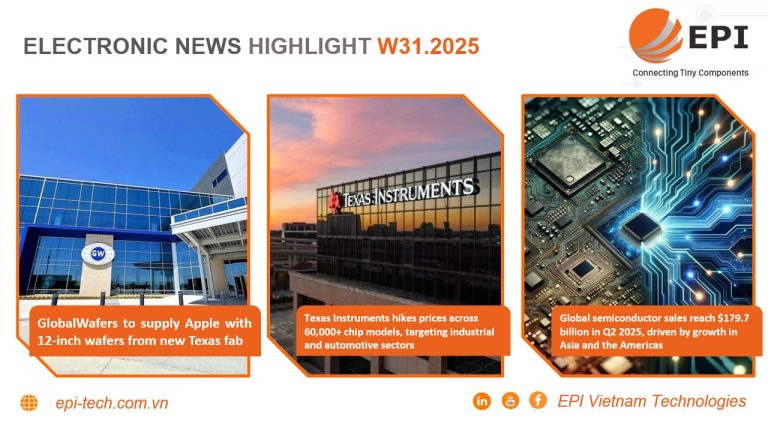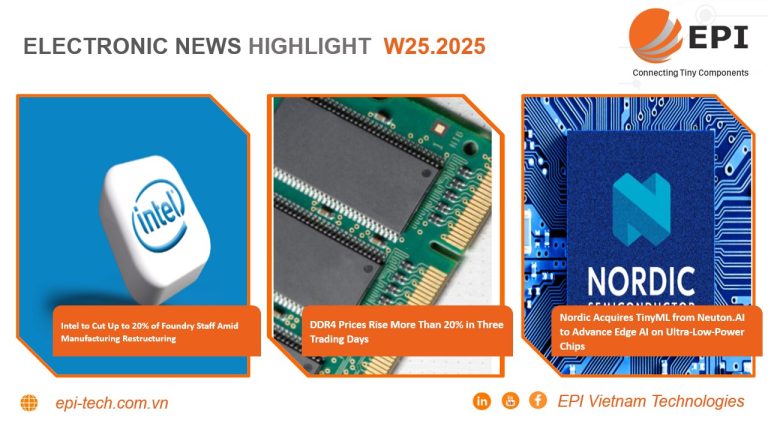ELECTRONICS NEW HIGHLIGHT W31.2025

1. GlobalWafers to supply Apple with 12-inch wafers from new Texas fab
GlobalWafers America LLC (GWA) has entered into a new partnership to supply 12-inch silicon wafers to Apple from its newly launched fab in Sherman, Texas.
This collaboration marks a significant step in strengthening the domestic semiconductor manufacturing ecosystem in the United States. GWA’s Sherman plant, which officially began operations in May 2025, represents a $3.5 billion investment and is expected to employ up to 650 engineers, technicians, and operations staff by the end of 2028.
GlobalWafers said the partnership with Apple reflects its long-term strategy to localize the production of critical semiconductor materials and support reshoring efforts in the U.S.
“Our wafers will be used in iconic Apple products like iPhones and iPads, which are known worldwide,” said Doris Hsu, Chairwoman of GlobalWafers. “We are proud to contribute to Apple’s supply chain with our advanced U.S.-made wafers.”
Sabih Khan, Apple’s Chief Operating Officer, stated that this initiative is part of the company’s broader “Made in America” program aimed at boosting U.S. manufacturing and job creation. Apple has pledged to invest $600 billion in the United States over the next four years.
GlobalWafers first announced its plan to build the Texas facility in May 2022 and held a groundbreaking ceremony in December 2022.
Learn more: GlobalWafers to supply Apple with 12-inch wafers from new Texas fab
2. Texas Instruments hikes prices across 60,000+ chip models, targeting industrial and automotive sectors
Texas Instruments (TI) announced a significant price increase on August 4, 2025, effective from August 15, 2025, affecting over 60,000 product models across its entire portfolio — a nearly 20-fold increase from a smaller adjustment in June 2025.
According to industry sources, the average price increase ranges from 10% to 30%, with more than 40% of affected components seeing hikes above 30%. The adjustment is focused heavily on high-value markets like industrial automation and automotive electronics. Distributors have begun relaying the new pricing to end customers, with a few strategic partners exempted.
This latest price change is not only broad but also strategically structural. TI appears to be phasing out older generations of chips by significantly raising their prices while keeping newer alternatives relatively stable. For example, a DCDC converter released in 2018 rose by 22%, while its modern replacement increased by just 5%.
The new pricing structure reveals distinct trends across different markets.
Industrial control products were among the most affected. Over 40% of industrial ICs saw price increases. For example, a 16-bit ADC used in factory automation jumped from $3.20 to $4.10, a 28% hike.
Automotive electronics also experienced sharp price adjustments. A battery management system isolator for electric vehicles rose by 22%, while power management ICs for infotainment systems increased between 18% and 25%.
Meanwhile, consumer electronics and telecom components saw more moderate changes. Prices for power management and RF front-end chips climbed by 5% to 15%. TI’s Q2 telecom revenue surged 50% year-on-year, indicating that these pricing changes may align with a broader product strategy shift.
The price hike is attributed to multiple factors — rising material costs, particularly for high-purity silicon wafers, as well as TI’s lower gross margin in the China market compared to global levels. The company seems to be using this opportunity to restructure regional profitability and boost the value proposition of its newer products.
While this move may pose short-term challenges for market share, it also creates opportunities for domestic chipmakers like SG Micro and 3Peak, which are expanding aggressively in industrial and automotive segments. Analysts also expect global competitors like ADI and Infineon to monitor and possibly follow TI’s lead.
TI’s decision underscores a broader shift in the semiconductor industry — from scaling production to enhancing value. Strategic pricing is emerging as a central lever in redefining global chip supply dynamics.
Learn more: Texas Instruments hikes prices across 60,000+ chip models, targeting industrial and automotive sectors
3. Global semiconductor sales reach $179.7 billion in Q2 2025, driven by growth in Asia and the Americas
Global semiconductor sales reached $179.7 billion in Q2 2025, a 7.8% increase from the previous quarter, according to the Semiconductor Industry Association (SIA). This figure reflects continued growth in chip demand, especially in Asia and the Americas.
SIA President and CEO, John Neuffer, noted that Q2 sales rose nearly 8% from Q1 2025 and were almost 20% higher than the same period in 2024. He attributed the strong year-on-year performance to robust growth in the Asia-Pacific (excluding China and Japan) and Americas regions. Neuffer expects the market to maintain this upward trajectory through the second half of 2025.
In June 2025 alone, global chip sales totaled $59.9 billion, a 19.6% increase from June 2024 and a 1.5% rise from May 2025.
By region, year-on-year sales growth was recorded in Asia-Pacific excluding China and Japan (+34.2%), the Americas (+24.1%), China (+13.1%), and Europe (+5.3%). Japan was the only region to see a decline, down 2.9% from 2024.
Month-on-month, sales edged up in Asia-Pacific excluding China and Japan (+5.8%) and in China (+0.8%), while declining slightly in the Americas (-0.2%), Europe (-0.7%), and Japan (-1.7%).
Learn more: Global semiconductor sales reach $179.7 billion in Q2 2025, driven by growth in Asia and the Americas
#ASEAN #AsiaPacific #distributor #Global #electronicdistributor #PCBA



 Tiếng Việt
Tiếng Việt  English
English 













